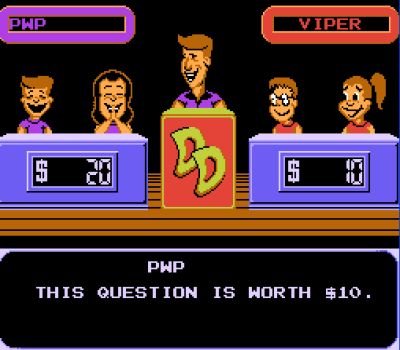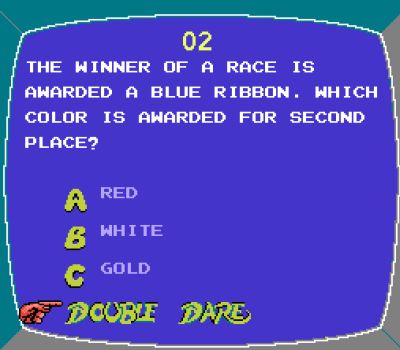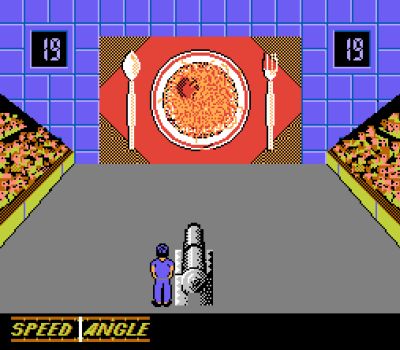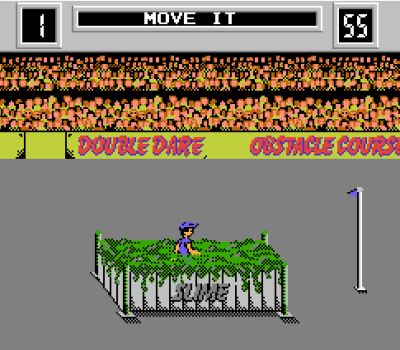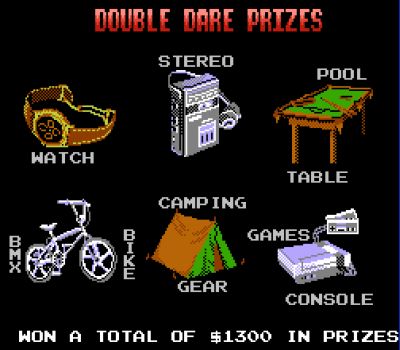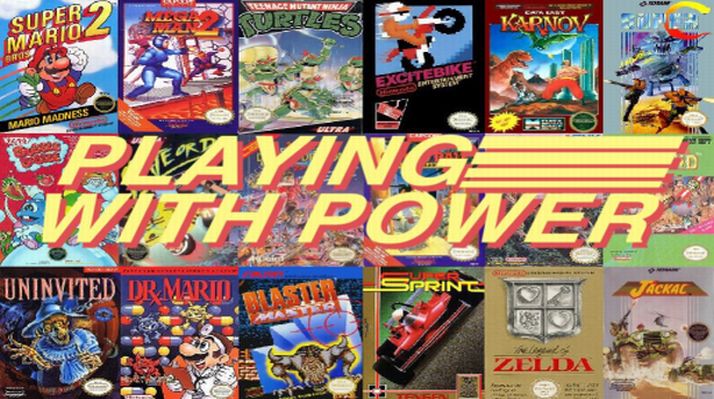 Welcome to another edition of Playing With Power. The review article that looks at all things Nintendo Entertainment System. And this week, I’m looking at something that’s a bit foreign to me, literally. Believe it or not, I have never ever seen a full episode of the classic kids game show Double Dare. Mainly because I don’t recall it airing in Canada, or at least on any station that I could watch it on. Now I’ve watched some clips, and know basic knowledge of it, but I’ve never watched an entire episode.
Welcome to another edition of Playing With Power. The review article that looks at all things Nintendo Entertainment System. And this week, I’m looking at something that’s a bit foreign to me, literally. Believe it or not, I have never ever seen a full episode of the classic kids game show Double Dare. Mainly because I don’t recall it airing in Canada, or at least on any station that I could watch it on. Now I’ve watched some clips, and know basic knowledge of it, but I’ve never watched an entire episode.
We did have a decent enough version in the mid to late 90’s show Uh-Oh!, but when it comes to the original true Double Dare, it’s all greek to me. So maybe that will make my opinion on the NES version of the game a bit more neutral. So, do I “Dare” take on this challenge? Let’s see.
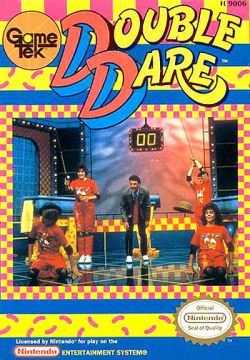 YEAR OF RELEASE: 1990
YEAR OF RELEASE: 1990
PUBLISHER: Gametek
GENRE: Game Show
Double Dare was a kids game show that aired on Nickelodeon from 1986-1993 (Returning in 2000 as well). The premise of the game show mixed trivia questions with messy and fun physical challenges. It was one of Nickelodeon’s first major hits, and is often considered one of the greatest game shows of all time.
The popularity of Double Dare was so massive, that a video game would clearly be a logical option. Double Dare first saw a video game release on the PC in 1988, but would see a later port to the NES two years later in 1990. Both ports were published by GameTek
GameTek was a video game company that was best known for their game show adaptations to various consoles, including computers, and of course, the NES. With Rareware often the developers for their games, the company would go on to release many game show games such as Jeopardy, Wheel of Fortune, Classic Concentration, Hollywood Squares, and the game of choice this week, Double Dare. But how well does this game handle? Let’s find out.
COVER STORY
I think this cover is kinda bland. The pic used to represent the show is kinda forgettable and doesn’t fully represent the game show all that well. But then again, this is from someone who doesn’t know much about the show. What I do like however is the wacky borders on the box that just give that early 90’s feel that I love so much. Is it the most eye catching cover? Probably not. But for what it is, I guess it will still catch the eyes of fans of the game show.
GAMEPLAY
Double Dare is a 1-2 player game show game. You control your team as you answer questions, and play messy and silly physical challenges. You start the game by choosing the number of players, the difficulty of the AI if playing 1-player, the name of your team, as well as your character’s avatar.
You will start the game by finding out which team will go first by playing one of three different mini-games, either putty golf, hungry clown, or gorilla grab. At the bottom of your screen you’ll see a meter with SPEED and ANGLE on them. The object of the game is to stop the meter at the right speed and angle to get your item into the goal. Although with the Gorilla, you also have to wait until his hand is open to catch the banana you lob.
The winning team gets 10 dollars, and you move on to the main meat of the game, which is trivia. Each round has 10 questions, each an A, B, or C multiple choice question. Answer correct, and get the money. Get it wrong, and you lose your turn as well as earn no extra cash. And yes, because this is a late 80’s/early 90’s video game, get ready for dated questions. So, I hope you watched your fair share of Airwolf and Moonlighting before playing.
The catch to the trivia question is that if you don’t know the answer, or want to try to double your cash, you can choose the “Dare” option, to place the heat on the opposing team, in hopes that they get it wrong, and you can earn the money placed in the dare. However, this can backfire, as the opposing team can issue a “Double Dare” which now doubles the doubled money wager. To put it in simple terms, a regular question is worth 10 dollars, a dare is worth 20, and a double dare is worth 40.
You can now either try to answer the question, or you can go for the final option, which is the physical challenge. Physical challenges are similar to the game you played in the first part of the game. They consist of more games with speed and angles like the Spaghetti Shoot, or the Putty Golf.
Or they may be ones where you have your team mate throw something, and you have to catch it. These types of games include the Cake Toss, or the Kangaroo Throw. Win the physical challenge to earn all the money. But lose, and the opponents get the prize.
After the 10 questions, you’ll move on to half time, which is pretty much the same types of angle and speed mini-games as before, like cantaloupe bowling. After that, more questions, which are now doubled in points. Which broken down is 20 dollars a question, 40 per dare, and 80 per double dare/physical challenge. This is definitely the make or break round of the game.
At the end of the 2nd trivia round, comes the final round of the game, which is the infamous Double Dare obstacle course. The winning team now has to trudge through 8 different obstacles, and grab the flags in each part of the course, before time runs out. This is the hardest part of the game bar none, and almost unfair at points.
Controlling the character is weird since you need to move the d-pad back and forth to get up certain obstacles, then you have to be right below the flag, and jump with the A button. You have to trudge through slime, climb across monkey bars, climb a mountain, run a hamster wheel, and get to the finish line… in 60 seconds! You may think that’s enough, but trust me, you’ll likely be at the 5th or 6th obstacle at best before the timer runs out. And with the annoyance of the controls, that is definitely a challenge.
Do that, and you win a bunch of prizes that you sadly won’t really have like a game system, a watch, and a new BMX bike. Other than that though, the gameplay is pretty decent, and other than the obstacle course, everything controls well. And the physics work great too, although it takes a while to get exactly the right angles and speed needed for certain ones.
GRAPHICS
Graphics are okay, albeit a bit muddy colored during most of the physical challenges. Sprites for the characters are decent, although they do get used often in other GameTek games (I swear I’ve seen a couple of them in the Junior Editions of Wheel of Fortune and Jeopardy). It captures the look of the show I guess, so it works on that end.
MUSIC
There’s nothing too special about the music in the game. There’s no bad songs, but nothing about the soundtrack makes you want to come back for more. The best song in the game is easily the decent 8-bit rendition of the Double Dare theme song at the start of the game.
TUNE OF THE GAME
The choice for tune of the game easily goes to the game’s title screen, which is actually a fairly accurate version of the Double Dare theme song for an 8-bit console. while not the finest Rare soundtrack, this still stands out as a solid piece of work by the brilliant David Wise.
OVERALL THOUGHTS
Double Dare is An okay at best game show video game. It has a great amount of content with the challenges, has decent graphics and sound. The controls could have been tightened a bit more for the physical challenges, but they all work well enough that it never really hinders the game. But the only downside is the obstacle course, which has insufferable controls.
I’m not too familiar with the game show, so I don’t know how accurate or how much of a departure it is, but I enjoyed this video game port for the most part. But I can’t give it a thumbs up based entirely on the obstacle course. It really feels like the ultimate hindrance to what could have been a solid game show video game. However, this is my opinion. You may have more fun with it than I did, but to me, it’s a dare I don’t want to double.
RATING: Thumbs Down

